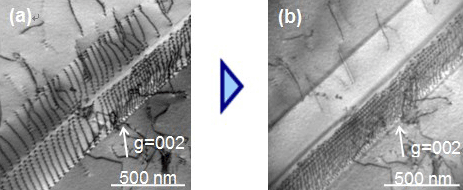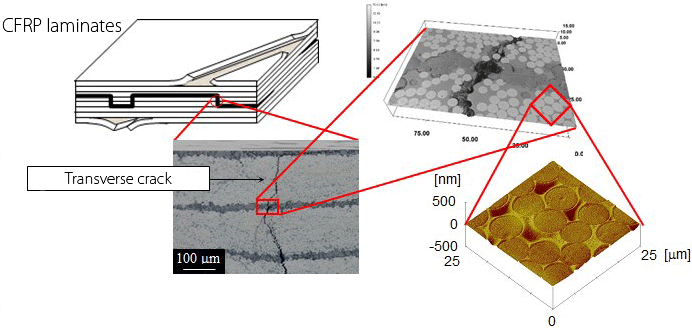Research
Development of a healing technique of fatigue crack in metallic materials
It is essential to establish a healing technique of fatigue cracks in metallic materials to improve the safety and long-term durability of machines and structures for which fatigue fracture is the most common cause of failure. We have proposed a healing technique based on the atom diffusion phenomenon by controlling high-density electric fields and the heat-treatment conditions. We have succeeded in crack closure, dislocation motion, and annihilation by applying high-density electric currents, and were able to heal cracks and recover 70% of the strength by controlling the heat treatment conditions. These healing techniques make it possible to improve the long-term reliability of structures and to reduce maintenance costs and the environmental impact.
Papers:
- Atsushi Hosoi, Kishi Tomoya and Yang Ju, Healing of fatigue crack by high-density electropulsing in austenitic stainless steel treated with the surface-activated pre-coating, Materials, 2013, 6(9), 4213-4225. (doi:10.3390/ma6094213)
- Yongpeng Tang, Atsushi Hosoi, Yasuyuki Morita and Yang Ju, Restoration of fatigue damage in stainless steel by high-density electric current, International Journal of Fatigue, 2013, 56, 69-74. (doi:10.1016/j.ijfatigue.2013.08.012)


(a) before and (b) after electron collision.
Evaluation of the long-term reliability of CFRPs
Carbon fiber reinforced plastics (CFRPs) are currently used as the main structural members of airplanes because they are light and have high strength and stiffness. Additionally, they are expected to replace metallic materials in large structural members of automobiles, railway vehicles, wind turbine blades, tidal turbine blades, etc. Therefore, it is important to evaluate the long-term durability and reliability of CFRP structures. We have evaluated the fatigue damage behavior of CFRP laminates on different length scales and have proposed different models to quantitatively predict fatigue life and damage initiation.
Papers:
- Tsuyoshi Miyakoshi, Takeru Atsumi, Kensuke Kosugi, Atsushi Hosoi, Terumasa Tsuda, Hiroyuki Kawada, Evaluation of very high cycle fatigue properties for transverse crack initiation in cross-ply CFRP laminates, Fatigue & Fracture of Engineering Materials & Structures, 2022, accepted.
- Atsushi Hosoi, Shigeyoshi Sakuma, Yuzo Fujita and Hiroyuki Kawada, Prediction of initiation of transverse cracks in cross-ply CFRP laminates under fatigue loading by fatigue properties of unidirectional CFRP in 90° direction, Composites Part A: Applied Science and Manufacturing, 2015, 68, 398-405. (doi:10.1016/j.compositesa.2014.10.022)
- Atsushi Hosoi, Narumichi Sato, Yasuyuki Kusumoto, Keita Fujiwara and Hiroyuki Kawada, High-cycle fatigue characteristics of quasi-isotropic CFRP laminates (Initiation and propagation of delamination considering the interaction with transverse cracks), International Journal of Fatigue, 2010, 32(1),29-36. (doi:10.1016/j.ijfatigue.2009.02.028)

Development of bio-inspired functional materials and understanding their mechanical properties
Biomaterials are composites of hard and soft materials, which often have complex, nanoscale hierarchical structures. The combination of hard and soft materials imbues biomaterials with desirable mechanical properties (they are lightweight and possess high strength and stiffness). For example, nacre is composed of hexagonal platelets of 98% aragonitic calcium carbonate and 2% organic compounds (proteins and polysaccharides) and is 3000 times stronger than monolithic calcium carbonate. We have developed bio-inspired functional materials and new composites with high bonding strength using highly-ordered and self-organized anodic oxidation nanoporous alumina.




